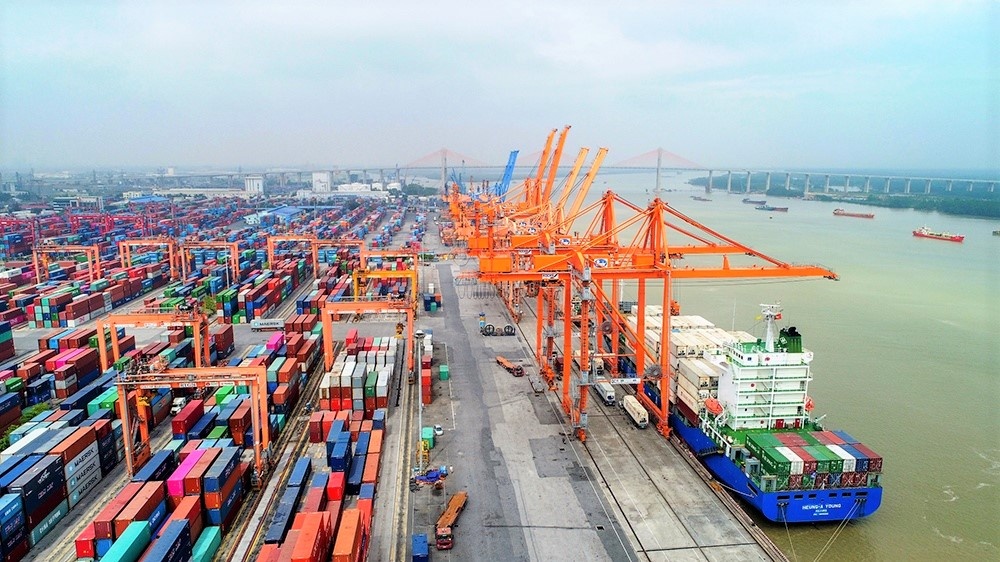Master plan sets out seaport revitalisation
 |
| Master plan sets out seaport revitalisation, photo: VGP |
At a meeting to announce the master plan for seaport development over the next 10 years in early October, Minister of Transport Nguyen Van The said that the ministry is working on special mechanisms that could create more favourable conditions for private investments in seaports.
The minister urged cities and provinces to work closely with the Ministry of Transport (MoT) on project development and investment attraction. According to Deputy Minister Nguyen Xuan Sang, the plan gives priority to international gateway and large-scale seaports serving the socioeconomic development of the country, as well as large-scale terminals serving industrial and economic zones.
“Private investment will make up 95 per cent of the $13.6 billion going into the development of seaports in this period. State funding will focus on public infrastructure and key areas to encourage investment,” Sang said.
Seaports are among the most attractive segments in the transport sector in this country thanks to a certain control of revenue sources. The plan could thus bring about more opportunities for investors, with domestic and international ventures enjoying equal potential.
Under the master plan, seaports could be able to handle 1.1-1.4 billion tonnes of goods and commodities by 2030, with container throughput reaching 38-47 million TEU. By 2050, the seaport system is hoped to be developed on par with regional and global counterparts.
According to the MoT, funding by corporations such as Hutchinson, PSA, DP World, APM Terminals, and SSA has changed the shape of Vietnamese seaports, especially the Cai Mep-Thi Vai port complex in the south.
Foreign investors also funded Lach Huyen International Gateway Port in the northern port city of Haiphong. In 2018, the first two foreign-invested terminals were put into operation through a joint venture between Saigon Newport Corporation, Mitsui O.S.K. Lines Ltd. and Itochu Group from Japan, and Taiwan’s Wan Hai Lines Ltd., rendering them the first public-private partnership port project in the country.
Before the pandemic, other investors from Japan, the United States, and South Korea also expressed strong interest in acquiring state stakes in major ports in Haiphong, Ho Chi Minh City, and Danang.
| Six major seaport clusters in the 2021-2030 master plan for Vietnam The first seaport cluster plan will focus on upgrading the Haiphong seaport system and upgrading Lach Huyen International Gateway Port for container throughput. Dinh Vu-Song Cam Port is to serve local industrial zones. Goods in bulk, liquid cargo, and gas form will be transported to the South Do Son and Van Uc areas. The South Do Son and Van Uc wharves are developed to not only promote the development of industrial zones and industrial clusters in the south of Hanoi-Haiphong Expressway but also present a driving force for the industrial development in the northern province of Thai Binh. Infrastructure around the northern seaport complex will be more favourable when the beltway 4 and the inland waterway port system along the Red River are put into use. The second seaport cluster lies in the central province of Thanh Hoa, alongside Tho Xuan Airport, Nghi Son Economic Zone, and a series of key national transport projects like the North-South Expressway, the North-South High-speed Railway. Moreover, the Hanoi-Vientiane expressway will connect with seaports. The third seaport cluster is in the central city of Danang, closely connecting to the south of Laos, the north of Cambodia, and the three-way crossroads of Indochina via Thailand. In addition, Danang International Seaport, the North-South High-speed Railway, and the North-South Expressway could act as a magnet for attracting regional economic development and investment. The fourth seaport cluster lies in the central province of Khanh Hoa. Van Phong Seaport has favourable natural conditions and deep stream depth, which could be developed into the largest gateway seaport in Vietnam. The fifth seaport cluster is the Cai Mep-Thi Vai port complex in the southern province of Ba Ria-Vung Tau. The cluster is promising fresh opportunities following the opening of a series of expressways, including Bien Hoa-Vung Tau, beltways 3 and 4, and Ben Luc-Long Thanh, among others. The last seaport cluster is Tran De Seaport. At present, the Mekong Delta region is home to Can Tho International Airport, connecting inland waterways and a road system. However, currently this seaport can accommodate a limited number of vessels, and regional cargo for export to the EU and the United States has to go through Ho Chi Minh City and the Cai Mep-Thi Vai connection, with high transportation costs involved. Source: Ministry of Transport |
What the stars mean:
★ Poor ★ ★ Promising ★★★ Good ★★★★ Very good ★★★★★ Exceptional
Related Contents
Latest News
More News
- Global partnerships key to Vietnam’s IFC development (December 26, 2025 | 16:18)
- Vingroup pulls out of bid to invest in North-South high-speed railway (December 26, 2025 | 11:42)
- Strengthening supply chains through trade promotions and customs reform (December 24, 2025 | 14:00)
- PM orders investment model for North–South high-speed rail (December 22, 2025 | 17:43)
- LS Eco Energy to invest in Vietnam rare earth sector (December 22, 2025 | 17:31)
- Government moves to establish International Financial Centre (December 21, 2025 | 21:00)
- Vietnam's IFC to target global investment flows (December 21, 2025 | 18:00)
- Two national hospitals expand capacity with new facilities (December 20, 2025 | 09:00)
- Ha Tinh breaks ground on major Vingroup industrial and energy projects (December 19, 2025 | 18:24)
- EVN launches major power infrastructure projects nationwide (December 19, 2025 | 18:17)

 Tag:
Tag:





















 Mobile Version
Mobile Version